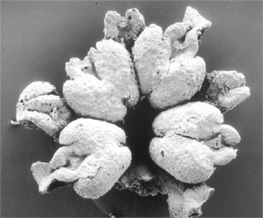Phylogenetic Relationships, |
I am interested to investigate patterns and processes in the evolution of major tracheophyte lineages, including their phylogenetic relationships, time of origin, and rate of species diversification. The living tracheophyte lineages are ancient representatives of a much larger, presently extinct, historical diversity. The emerging molecular phylogenetic picture depicts several results unexpected from the perspective of morphological similarity, for example, the inclusion of Equisetum within ferns, the monophyly of living gymnosperms, and the sister relationship between Gnetales and Pinaceae. These relationships may nevertheless hold the key to a better understanding of tracheophyte evolution. Which extinct seed plant lineages are more closely related to the living gymnosperms, and which to angiosperms? Which is the sister taxon to the angiosperms? What are the homologies of the numerous synapomorphic angiosperm attributes? Are the Gnetales an extremely divergent branch within the conifers? If not, is it because of a (non-genealogical) biological phenomenon, or because of artifacts in phylogeny estimation that they are recurrently resolved in this position?
 |
Angiosperms concentrate the great majority of tracheophyte living species diversity, followed distantly by the ferns. Within these two clades, species diversity is unevenly distributed. Age estimates based on gene sequence data and the assumption of a molecular clock suggest that several tracheophyte lineages, and angiosperms in particular, are much older than their oldest fossils. What is the time of origin of tracheophyte lineages? What is the time lapse between their origin and the diversification that lead to their extant diversity? How was their extant diversity obtained – through a slow accumulation of species through time, or as the result of a recent radiation? How and when did the extraordinary diversity of angiosperms arise? |
The research that I have conducted on these topics is of a varied nature. I compiled a synthesis of the major clades within eudicots and their relationships, standing diversity and earliest fossil record. Through an analytical procedure that accounted for rates of speciation and extinction, the absolute rate of species diversification of angiosperms and of angiosperm clades was estimated, and lineages that are unexpectedly species-rich or species-poor were identified. Through explicit phylogenetic analyses using molecular sequence data, I investigated the relationships among extant seed plant lineages, and explored the effect of different genes, different codon position partitions and different optimization criteria in phylogeny estimation. I am currently involved in several studies estimating lineage divergence times using “molecular clock” methods that account for molecular rate heterogeneity, and that allow the use of auxiliary independent chronological information, derived from a critical analysis of the fossil record. I have finalized a study in which the ages of major seed plant clades, with a special focus on the angiosperms, were estimated, evaluating the effect of different genes, different codon positions and the implementation of temporal constraints on the ages of nodes. In a collaborative research, we estimated the age of diversification of the derived ferns (Pteroids and Eupolypods), a clade that includes a major proportion of fern living diversity, and compared the estimated age with the timing of angiosperm diversification. I am currently conducting an investigation about the time of origin and diversification of the early diverging eudicot lineages. In addition to comparing age estimates resulting from different analytical methods, I estimate the rate of species diversification to document differential modes in which standing diversity of early eudicot lineages was acquired.
|
|